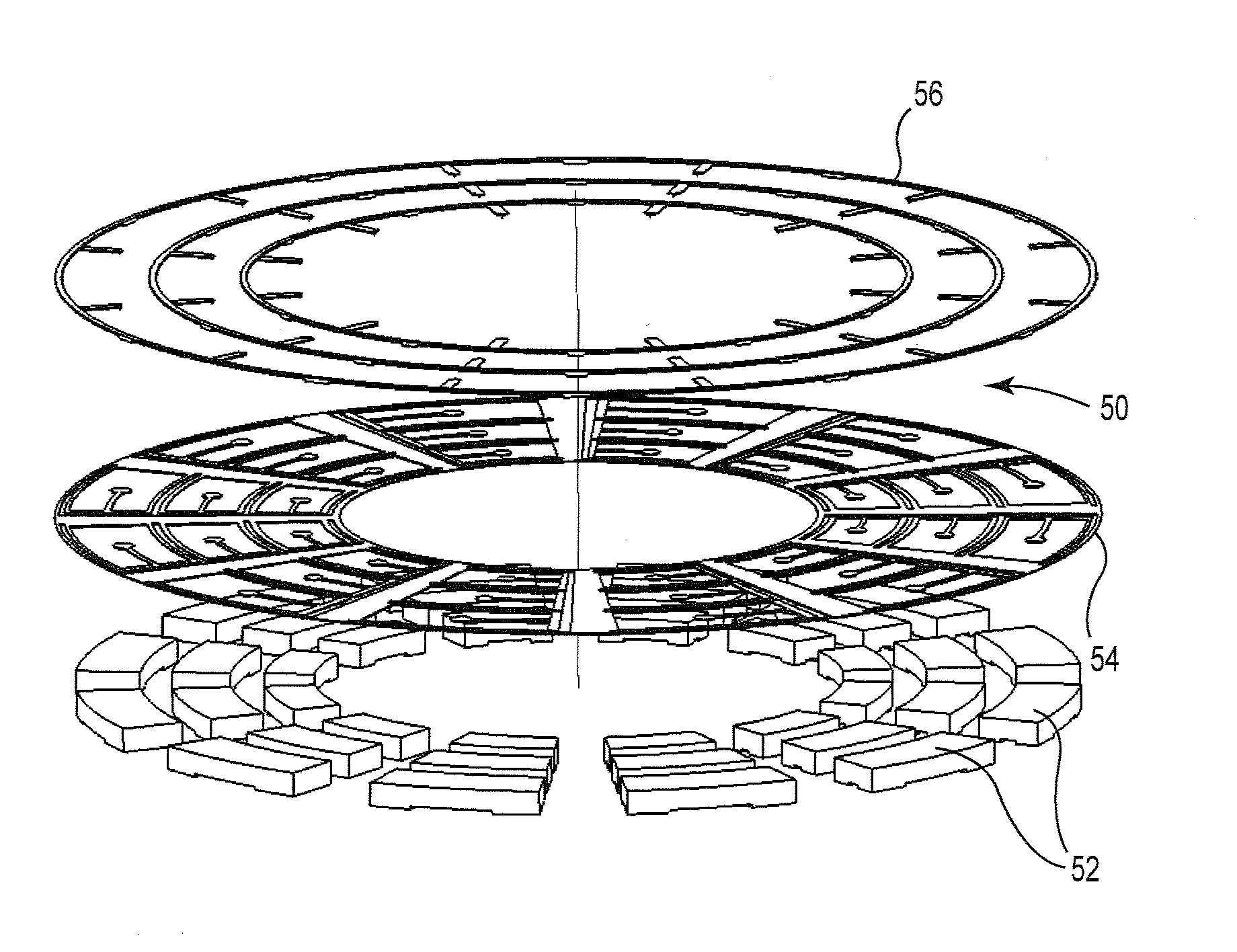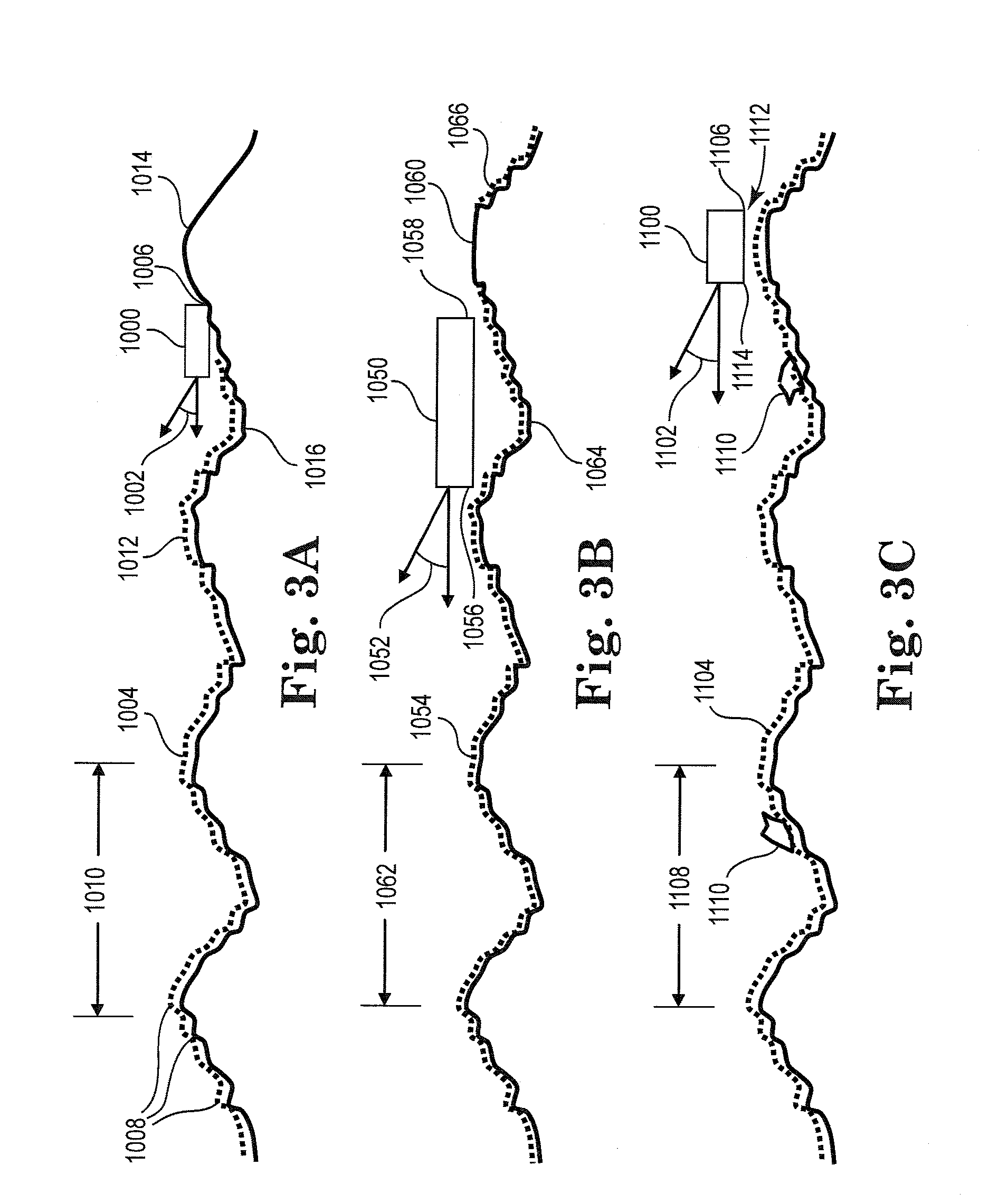Array of abrasive members with resilient support
a technology of resilient support and abrasive components, which is applied in the field of abrasive articles, can solve the problems of loss of head media spacing, roughness at the rounded areas, and magnetic damage due to etching of magnetic materials
- Summary
- Abstract
- Description
- Claims
- Application Information
AI Technical Summary
Benefits of technology
Problems solved by technology
Method used
Image
Examples
example 1
[0211]FIG. 47A illustrates an abrasive member 800 modeled for topography following applications. The leading edge 802 includes a plurality of discrete features 804 separated by cavities 806 that permit air flow and particles to enter. The cavity depth 812 is about 2 micrometers to about 3 micrometers to promote a negative suction force.
[0212]The leading edge pads 804 are formed with rounded surfaces 816 to promote the redistribution of debris and lubricant. This example of a low contact force abrasive member 800 includes leading edge step 818 that increases lift at the leading edge 802.
[0213]FIG. 47B is a graphical illustration of the contact pressure of the abrasive member 800 with the substrate. The leading edge pressure 802A is preferably zero. Trailing edge pressure 810A shows a minor negative suction force. Upon application of large loads (e.g., up to 12 grams) the leading edge 802 does not contact the substrate, while the trailing edge 810 follows the topography of the substra...
example 2
[0215]FIG. 48A illustrates an abrasive member 820 modeled for topography following applications. The leading edge 822 includes a plurality of discrete features 824 separated by slots 826 that permit air flow and particles to enter. This example of a low contact force abrasive member 820 includes leading edge step 828 and extended sides 830 to increase the negative pressure force (suction force). The leading edge step 828 has a depth of about 0.1 micrometers to about 0.5 micrometers to promote the formation of higher pressure at the leading edge 822. Note that the trailing edge 832 is formed of discrete pads 834 to reduce the spacing between the substrate and the abrasive member, and to allow for circulation of lubricant and debris.
[0216]FIG. 48B is a graphical illustration of the contact pressure for the abrasive member 820 against the substrate. The contact forces are concentrated at the pads 834 located at trailing edge 832. The negative pressure saturates around 3.5 grams while t...
example 3
[0218]FIG. 49A illustrates an abrasive member 840 modeled for topography removing applications. The leading edge 842 includes a plurality of discrete features 844 separated by slots 846 that permit air flow and particles to enter. The trailing edge 848 similarly includes a plurality of discrete features 850 separated by slots 852. The features 844, 850 have a height 854 of about 2 micrometers and are formed with rounded leading edge surfaces to distribute both lubricant and wear debris.
[0219]The height 854 is sufficient to create a positive pressure profile at the top of the pads 844, 850 and a negative suction force at the trailing side 845 of the features 844 in cases of air as a lubricant. The proper selection of the pressure distributions controls the pitch angle of the abrasive member 840 and the minimum spacing above the substrate.
[0220]In the case of topography removing, the abrasive member 840 does not follow certain target wavelengths of waviness. The pitch angle of the abr...
PUM
| Property | Measurement | Unit |
|---|---|---|
| peak-to-valley roughness | aaaaa | aaaaa |
| peak-to-valley roughness | aaaaa | aaaaa |
| roughness | aaaaa | aaaaa |
Abstract
Description
Claims
Application Information
 Login to View More
Login to View More - R&D
- Intellectual Property
- Life Sciences
- Materials
- Tech Scout
- Unparalleled Data Quality
- Higher Quality Content
- 60% Fewer Hallucinations
Browse by: Latest US Patents, China's latest patents, Technical Efficacy Thesaurus, Application Domain, Technology Topic, Popular Technical Reports.
© 2025 PatSnap. All rights reserved.Legal|Privacy policy|Modern Slavery Act Transparency Statement|Sitemap|About US| Contact US: help@patsnap.com



